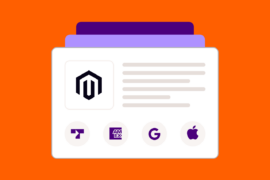We all have woken up to a “Happy birthday!” greeting from our dentist or a subscription we barely remember signing up for. While sifting through generic birthday or anniversary wishes from corporations may be somewhat of a tradition at this point, there are always some outliers that really knock the personalization aspect out of the park and make us think, “Hey, I should check them out.”
There lies the true power of personalization in communication between companies and their clients. Retailers can provide excellent experiences that go beyond just shopping, resonating with customers long after the initial purchase.
But how can you measure the effectiveness of your personalization strategies? We’ll take a look at some of the most crucial personalization metrics you should monitor to enhance customer engagement, build loyalty, and ultimately drive sales.
Why is personalization important
Before we dive into the numbers and calculation formulas, let’s explain why personalization is so important in retail.
Personalization is no longer an exception, as customers have grown to expect it. In fact, according to McKinsey & Company, 71% of consumers expect brands to deliver personalized messaging. Even more importantly, 76% experience frustration when this doesn’t happen. This statistic clearly shows just how significant personalizing your interactions is for building relationships and maintaining your customer base.
This is not lost on retailers and marketers. As much as 89% of online businesses are heavily investing in personalization. E-commerce platforms continuously add personalization features to improve shopping experiences and keep their customers engaged. However, in order to do that, it is vital to track the right metrics.
Customer engagement metrics
Essentially, customer engagement metrics serve as tools to measure how well is your business connecting with its customers. They track aspects, such as how often customers visit your online store, how they interact with content, and how long they stay engaged. Such insights help businesses understand if they’re keeping customers interested.
Click-through rate
Click-through rate (CTR) measures how effectively an ad or a link entices your website visitors to click on it. CTR is calculated by dividing the clicks by the number of times the ad or link was displayed. For a percentage, multiply your result by 100.
CTR = (Number of impressions / Number of clicks) × 100
An average CTR is somewhere between 3-5%. A high CTR suggests that your produced content is relevant and effectively engages your audience.
Graph showing the average CTR across different industries.
Average time on page
This is the time between a visitor arriving at your web page and then moving on to a different one or leaving your site altogether. When visitors spend a longer time on your pages, it indicates that the content is relevant and engaging. Adding personalized elements to your content helps raise time spent on the page.
You can calculate it by dividing the total amount of time all users spent on a page by the number of users who viewed that particular page.
Average time spent on page = Number of users / Total time spent on page
You can also gauge this metric using search analytics tools that monitor how visitors interact with content throughout your website.
Around 52 seconds is considered a good average time spent on a page.
Bounce rate
Bounce rate tracks the percentage of visitors who land on your page and leave without further interactions. To calculate your bounce rate, divide the number of single-page sessions by the total number of sessions over a certain time period.
Bounce rate = Single-page sessions / Total sessions
When you’re experiencing a high bounce rate, it might mean your landing page’s content isn’t engaging or relevant enough, leading website visitors to “bounce”.
An average bounce rate for retail and e-commerce websites is around 20-45%, according to Customedialabs.
Conversion metrics
Analyzing these metrics will help you gauge how effective are your personalization strategies in leading users toward desired goals. Additionally, keeping an eye on conversion metrics will clearly show you areas where you need to make adjustments or identify which products generate the highest conversions based on customer search behaviors.
Luigi’s Box search and discovery analytics
Conversion rate
This is among the most important metrics when you’re trying to assess the effectiveness of our personalization marketing campaigns. A conversion rate represents the percentage of visitors who complete a desired action. This could be subscribing to a newsletter, filling out a form, or making a purchase.
To calculate your conversion rate, divide the number of conversions by the total number of interactions with a particular piece of content during the same period. To calculate the percentage, again multiply the result by 100.
Conversion rate = (Total number of interactions / Number of conversions) × 100
The average conversion rate is somewhere between 2-5%, depending on the content type.
Average order value (AOV)
This is a fairly straightforward metric indicating how much, on average, each customer spends per transaction. To calculate AOV, divide the total revenue by the number of orders over a specific time period.
AOV = Number of orders / Total revenue
AOV is a great metric to gauge the effectiveness of personalized recommendations, as well as upselling and cross-selling efforts.
Cart abandonment rate
This metric shows the percentage of customers who add items to their shopping carts but abandon them without making a purchase. To calculate the cart abandonment rate, subtract the number of completed transactions from the number of carts created, and divide the result by the number of carts created. To get the percentage, multiply it by 100.
Cart abandonment rate = (1 − Number of carts created / Number of completed transactions) × 100
This calculation is quite complex, so using analytics software that tracks and provides detailed reports might be the right option.
Interestingly, research shows that in 2023, the percentage of online shopping carts being abandoned reached 70% for the first time since 2013.
Graph showing the development in cart abandonment over the years
Learning your business’s cart abandonment rate is crucial, as it helps you understand how many potential sales you lose during checkout. These insights will help you devise strategies to improve the checkout experience.
Customer retention and loyalty metrics
Understanding customer behavior and sentiment is the bread and butter of developing personalization strategies. Customer retention and loyalty metrics track how well you are keeping your existing customers and what are their feelings toward your brand.
Repeat purchase rate
Returning customers are a sign of satisfaction and loyalty, so tracking this metric is paramount. Repeat purchase rate measures the portion of your customers who make more than one purchase. To calculate it, divide the number of returning customers by the total number of customers, and multiply the result by 100 to get a percentage.
Repeat purchase rate = (Total number of customers / Number of returning customers) × 100
A higher repeat purchase rate means that customers are satisfied with your products and services, while lower rates indicate that you should revise your strategies.
Additionally, referral marketing is a powerful tool for boosting customer retention, as well as acquisition. Use rewards or discounts as an incentive for happy customers to recommend your brand to their friends and family. You can use this word-of-mouth marketing to foster a community of brand advocates that are loyal to your brand.
Customer lifetime value (CLV)
CLV measures the total revenue your business expects to earn from a customer throughout their relationship. Rather than focusing on a purchase-by-purchase value, CLV considers the long-term relationship between a customer and your company. How well you personalize customer experiences often directly impacts this metric.
Calculating the CLV metric can be complex, and there are several ways how to do this. We are going to look at the most basic formula.
CLV = Customer value × Average customer lifespan
To break it down, customer value is the revenue a customer brings to your business, while the average customer lifespan is the duration of their relationship with your company. Multiplying these two values will give you the total revenue you can expect from a single customer over their lifetime.
Of course, this is a simplified version, leaving out some more intricate variables. To effectively track CLV, there are many calculators and analytics solutions you can use to get the most precise results.
Net promoter score (NPS)
Have you ever received a message from a business asking you to rate them, most often by choosing a number from one to ten, or clicking on a smiley face? This is how they get data for measuring their NPS.
Example of an NPS survey
NPS, initially created by Bain & Company in 2003, measures loyalty by asking customers how likely are they to recommend your business in their social circles. When measuring NPS, there are three groups of responders:
- Promoters: They score 9-10 and are likely to recommend you to their friends and family. Promoters are considered loyal advocates of your business.
- Passives: Scoring 7-8, these customers are satisfied with their experience, but can’t be considered enthusiastic. They might recommend your business, but it is less likely.
- Detractors: These unhappy customers score 0-6 and may spread negative feedback in their social circles.
To determine the NPS, you just need to subtract the percentage of detractors from the percentage of promoters.
NPS = %Promoters − %Detractors
Although a higher percentage is better, what is considered a good NPS highly depends on each individual company. When deciding on your target score, take into account industry benchmarking data, current business insights, and market intelligence.
Now that we have explored these metrics in detail, you might be asking yourself “What does that mean for my digital business?”. The answer is quite clear. You can’t afford to fall behind in your personalization strategy. Although competition is fierce, with the right approach and Modern Magento features, you can make your customers feel heard and appreciated and set yourself apart in the market.
Examples of successful personalization strategies
Now that you know which metrics you should use to track your personalization strategies’ performance, let’s get you some inspiration. Below we will discuss three brands whose personalization strategies helped them make a name for themselves and deliver outstanding customer experiences.
Spotify
Personalization has always been at the forefront of Spotify’s marketing efforts. From the beginning, they have been implementing algorithms to achieve hyper-personalization, starting from Hack Week. This evolved into the well-loved Discover Weekly, Blend, or the annual Wrapped campaign.
Today, Spotify offers personalized playlists for each listener. They have introduced DJ, an AI hyper-personalized guide that considers your past favorites to recommend new music, and finds that one song that has been stuck in your head for weeks, but you could not identify.
Spotify’s Wrapped for 2023
Spotify truly drives the personalized aspect home with the app’s ability to integrate with other platforms, such as Google Sheets, Slack, or Discord for an uninterrupted listening experience no matter what you’re doing. You also have the option to check out your statistics, which include your favorite genres as well as your top songs and artists..
Personal listening stats in Spotify
Sephora
Sephora, a personal care and beauty chain utilizes personalization on all fronts. Virtual Artist is an AR virtual try-on tool that lets you virtually apply Sephora’s beauty products. It also uses facial recognition technology and data from previous user interactions to offer tailored beauty tips, personalized product recommendations, and tutorials for a more engaging user experience.
Sephora’s Virtual Artist is used for virtual try-ons and providing personalized beauty tips.
Additionally, Sephora offers a tailored loyalty program—Beauty Insider. Features, such as customized rewards and personalized recommendations expand on the brand’s personalization efforts.
unction of Beauty
This personal care brand’s customization efforts are at the core of its business model. Function of Beauty uses quizzes and customer profiles to create products that are specifically tailored to each customer’s unique needs and preferences.
Function of Beauty’s Hair Quiz
Besides tailoring the formula to your requirements, you can pick your preferred scent and color, and even customize the label and packaging.
Conclusion
Customers seek brand interactions that feel personal and meaningful. Occasional newsletters with their name in the subject line are no longer enough, as companies step up their personalization efforts to meet growing customer expectations.
Behind every successful personalization campaign, there is a plethora of data to track and learn from. Engagement metrics, such as click-through rates let you know how well you are connecting with your customer base. Conversion metrics, like average order value and conversion rate, help you assess the effectiveness of your personalization strategies. Last but not least, loyalty metrics let you in on the depth of your customer relationships.
Tracking these metrics will help you better understand the needs and preferences of your customer base, and create more engaging shopping experiences. Remember, it’s all about making customers feel valued and appreciated. So, dive into the data and see the surge in engagement and sales.
Author’s Bio
Martina is a caffeine-fueled content writer with a background in tech and creative writing. When she’s not crafting content for Luigi’s Box, Martina enjoys exploring nature, reading, art, all things geeky, and making wonky crochet and knitted items.




